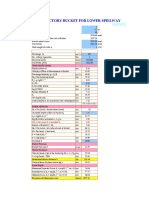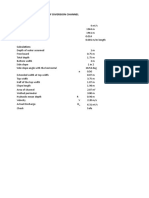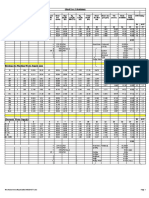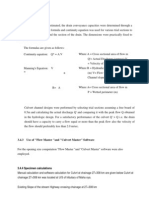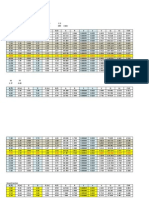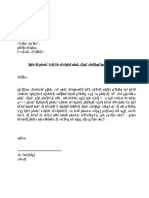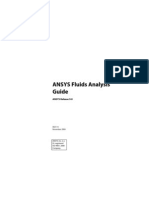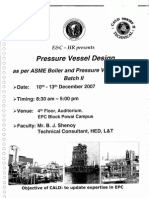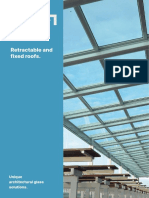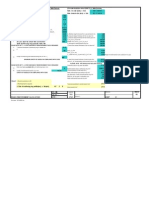Chhuba HEP Final Civil Design
Chhuba HEP Final Civil Design
Uploaded by
sarvannnCopyright:
Available Formats
Chhuba HEP Final Civil Design
Chhuba HEP Final Civil Design
Uploaded by
sarvannnOriginal Title
Copyright
Available Formats
Share this document
Did you find this document useful?
Is this content inappropriate?
Copyright:
Available Formats
Chhuba HEP Final Civil Design
Chhuba HEP Final Civil Design
Uploaded by
sarvannnCopyright:
Available Formats
Input Data
Design Discharge for Diversion Hume Pipe, Q = 6.00 cumec
Rugosity coefficient = 0.014
Length of Diversion Hume Pipe = 32.50 m
Invert level of Diversion Hume Pipe at entry = El.1314.00 m
Invert level of Diversion Hume Pipe at forebay = El.1308.00 m
Design Calculation:
Applying Manning's formula
where,
V = flow velocity
Manning's coefficient,N= 0.014
R= hydraulic mean depth
Bed slope of the Diversion Hume Pipe,S = 0.18
= 1 in 5.42
Check for discharging capacity of the pipe
Assumed D= 1.50 m
Assumed Radius = 0.75 m
Assuming depth of flow, d = 0.90 D
= angle projected by unwetted perimeter at the center of the pipe
B
A C
h= unwetted height above FSL = D (1- 0.9) = 0.15 m
wetted height above c/l of pipe, h
1
= D/2 - h = 0.600 m
Hydraulic Design of Diversion Hume Pipe
Let D be the diameter of the Diversion Hume Pipe.
Thus, /2= cos
-1
(h
1
/R)
/2= 0.64 Rad
= 1.29 Rad
Arc length of the unwetted perimeter, L = R= 0.97 m
Chord length at the maximum flow level = 2(d x (D-d)) = 1.2 m
Cross-sectional area of unwetted section
A
u
=
0.09 Sq.m
1.68 Sq.m
Wetted Perimeter,P = D-L= 3.75 m
Hydraulic mean depth, R = A
w
/P =
0.45 m
Actual velocity in Hume Pipe = 3.87 m/s
Thus, discharging capacity of the Hume Pipe
Q = 6.49 cumec
Thus, cross-section area of wetted section, A
w
= /4 x D
2
-A
u
=
Since, the discharging capacity of the Diversion Hume Pipe is more than the design discharge, the diameter
of the Diversion Hume Pipe is sufficient enough to pass the design discharge.
Input Data
Design Discharge for Power Generation = 2.36 cumec
Flow Required for Silt Flushing in Desilting tank= 20%
Flow required for leakage and overloading = 15%
Total Design Discharge for Trench weir intake = 3.19 cumec
Normal Water Level at intake location, NWL = El.1311.0 m
Provided Height of Intake Opening, H = 1.20 m
Provided Width of Intake Opening, W = 2.00 m
Geometry of Intake Structure
Height of Intake bellmouth = 0.33 H = 0.33 x 1.2 = 0.40 m
Velocity at Opening = 3.186/(1.2 x 2) = 1.3 m/s
Height of Intake Opening including bellmouth =1.2 + 0.4 = 1.60 m
Invert level of Intake Opening = 1311 - 2.1 = El.1308.90 m
Design discharge =20% of 2.36 cumecs = 0.47 cumec
Permitted velocity in the bed flushing pipe = 3.0 m/s
Length of bed flushing Pipe = 10.00 m
Provided diameter of bed flushing pipe, D = 0.45 m
Sill level of bed flushing pipe = 1308.9 - 0.5 = El.1308.40 m
Area of the bed flushing pipe = 0.7854 D
2
= 0.16 sq.m
Wetted perimeter = 0.25 D = 0.11 m
Wetted radius = A/P = 1.41 m
Velocity attained = Q/A = 3.0 m/s
Hydraulic Design of Trench Weir Intake
Since, the flow is free flow after the intake, water cushion is not provided above the top of
intake opening.
Hydraulic Design of Bed Flushing Pipe
The invert level of the bed flushing pipe is kept at 0.5 m below the invert level of the
trench weir intake.
Input Data
Design Discharge for Power Generation: 2.36 cumec
Flow required for Bed Load Flushing: 20%
Flow Required for Silt Flushing (HRT): 20%
Overload Requirement: 15%
Total Design Discharge: 3.66 cumec
Normal Water Level: El.1311.0 m
High Flood Level: El.1312.0 m
Average Bed Level at Weir: El.1311.0 m
Length of Weir: 15.0 m
Trench Weir Geometry
where,
Q = Design Discharge = 3.658 Cumecs
L = Width of Stream = 15 m
E
1
= Ratio of flow area to the Total area of Trash Rack = 0.5
E
2
= Ratio of opening in the Trash rack likely to be clogged = 0.5
C
d
= Coefficient of Discharge through trashrack opening = 0.46
L = Length of the Weir across the stream = 15 m
E = Specific Energy at any section of the stream in the Trench weir
B = Width of Trashrack (width of trench weir at top)
C = Coefficient of Discharge for broad crested weir = 1.53
E = 0.3 m
B = 0.9 m
Provide a width of 1.25 m from practical considerations. Provide the same width for the entire 15m Length.
Velocity Requrement:
Providing 0.4 m/s per meter width of the trench as allowable velocity through trashrack opening
Hence required width =
= 0.61 m
Width required (50% Clogging Criteria) = 2 x 0.61 = 1.21 m
Which is less than 1.25 m.
Hence, provided width of Trash rack is safe.
The hydraulic design of trench weir is carried out by first assuming some dimensions (Length and Width)of the trench weir and
then checking the same for discharging capacity. The discharge capacity of the weir should be more than the required diverted
discharge.
Hydraulic Design of Trench Weir
3
2
C.L.
Q
(E) Energy Spec. |
.
|
\
|
=
2gE .L. .C .E E
Q
B Weir, Trench of Width
d 2 1
=
2gE .L. .C .E E
Q
B Weir, Trench of Width
d 2 1
=
Check for Discharging Capacity of Trench Weir
Length of Water Way: 15.0 m
Design Discharge: 3.66 cumec
Top Width of Trench (T): 1.25 m
Let the water depth along the section of channel be "d"
Area A = T x d = 1.25 x d
Velocity head at the end of the Trench (H
v
)
Where "n" is a constant depending on bottom profile of Trench = 0.5
Velocity head (H
v
): 0.27 d
3.658 = 4.6d^(3/2)
d = 0.86 m
Say 0.9 m.
Depth of Trench provided at Intake Location: 2.10 m
The Provided Depth of Trench at start: 1.10 m
Hence, provide waterway of 1.1 m at the start of the trench increasing to 2.1 m towards the intake end.
The bed slope of Tranch weir shall be proposed as 1V:15H
Check for Adequacy of Waterway
Average Depth of Trench = (1.1 + 2.1 )/2 m = 1.60 m
Average Flow Area = 1.25 x 1.6 sq.m = 2.00 Sq.m
Wetted Perimeter = (2 x 1.6 )+ 1.25 m = 4.45 m
Bed Slope of Trench = (2.1 - 1.1)/15 = 0.0667
Discharging Capacity of Trench, Q = 16.83 cumec > 3.658 cumec, Hence, adequate.
Check for Adequacy of Capacity with 50% Area Clogged
Average Depth of Trench = 1.6 /2 m = 0.80 m
Average Flow Area = 0.8 x 1.25 sq.m = 1.00 Sq.m
Wetted Perimeter = (2 x 0.8 )+ 1.25 m = 2.85 m
Bed Slope of Trench = (2.1 - 1.1)/15 = 0.0667
Discharging Capacity of Trench for 50 % clogging, Q
50
=
7.14 cumec > 3.658 cumec, Hence, adequate.
Using Manning's formula with value of n = 0.018,
Q = A2gHv = 2d(2g0.27 d)
1.25 x 2
2d
.
1 0.5
0.5
Hv
+
=
2T
A
.
1 n
n
Hv
+
=
Input Data
Design Discharge for Power = 2.36 cumec
Flow Required for Silt Flushing in Desilting tank= 20%
Flow required for leakage and overloading = 15%
Total Design Discharge = 3.19 cumec
Restricted Velocity = 2.0 m/s
Rugosity Coeffieicent = 0.018
Average Bed Level at Weir = El.1311.0 m
Length of intake channel = 137.00 m
Intake Channel Design
Area required = Q/V = 3.19/2= 1.59 Sq.m
Providing Base Width, B = 2.00 m
Providing depth, D = 1.00 m
Cross sectional area provided = B x D = 2.00 Sq.m
Velocity = 1.59 m/s
Wetted perimeter = 2D + B = 4.00 m
Wetted radius = 0.50 m
S
1/2
= 0.046
S= 0.002
= 1 in 500
Invert level of intake Channel at trench weir = El.1308.90 m
Invert level of intake Channel at Starting of desilting tank = 1308.9 - 137 x 0.002
= El.1308.60 m
Hydraulic Design of Intake Channel
Input Data
Design Discharge for Power = 2.36 cumecs
Flow Required for Silt Flushing = 20%
Flow required for leakage and overloading = 15%
Average Design Discharge, Q = 2.95 cumecs
Particle size to be removed= 0.20 mm and above
Flow velocity, v
f
= 0.22 m/s
Settling velocity,v
s
= 2.75 cm/s
Length of bypass Channel including transition= 51.00 m
Design Calculation:
Width proposed, W= 4.50 m
Depth required, D = Q/(W x vf)= 2.90 m
Adopted depth , D = 3.00 m
Hence, horizontal velocity = Q/(W x D) = 0.22 m/s
Moderated settling velocity, v
m
= v
s(
(1 - 0.132)/(D^(0.5)))
= 2.54 cm/s
= 0.025 m/s
Settling length = (flow through velocity/moderate settling velocity) x depth
= 25.80 m
Say = 26.00 m
Invert Level of HRP at intake = 1308.6 - 51 x 0.002
= El.1308.50 m
Provide 26 m long settling basin with trapezoidal bottom and silt gutter of 600 mm x 600 mm.
Hydraulic Design of Desilting Tank
The connection between the rectangular channel and desilting basin at inlet has been provided by way of 3.5m long expansion transition and outlet by way of 3.5 m
long contraction transition.
Input Data
Design Discharge for Power = 2.36 cumec
Flow required for leakage and overloading = 15%
Total Design Discharge for HRP, Q = 2.71 cumec
Rugosity coefficient = 0.012
Allowable velocity = 2.0 m/s
Length of HRP = 2291.00 m
Invert level of HRP at entry = El.1308.50 m
Design Calculation:
Invert level of HRP at forebay = El.1304.30 m
Applying Manning's formula
where,
V =allowable velocity = 2.00 m/s
N= Manning's coefficient = 0.012
R=hydraulic mean depth
S=bed slope of the HRP = 0.0018 545.4761905
= 1 in 540
Thus,
R=(V x N/S
1/2
)
3/2
= 0.42 m
Check for discharging capacity of the pipe
Assumed D= 1.50 m
Assumed Radius = 0.75 m
Assuming depth of flow, d = 0.80 D
= angle projected by unwetted perimeter at the center of the pipe
B
A C
h= unwetted height above FSL = D (1- 0.8) = 0.30 m
wetted height above c/l of pipe, h
1
= D/2 - h = 0.450 m
Let D be the diameter of the Head Race Pipe.
Hydraulic Design of Head Race Pipe
Thus, /2= cos
-1
(h
1
/R)
/2= 0.93 Rad
= 1.85 Rad
Arc length of the unwetted perimeter, L = R= 1.39 m
Chord length at the maximum flow level = 2(d x (D-d)) = 1.2 m
Cross-sectional area of unwetted section
A
u
=
0.25 Sq.m
1.52 Sq.m
Wetted Perimeter,P = D-L= 3.32 m
Hydraulic mean depth, D
w
= A
w
/P =
0.46 m
Actual velocity in Headrace Pipe= Q/A
w
=
1.79 m/s
Thus, discharging capacity of the HRP
Q = 3.37 cumec
Design of thickness of HRP
Thickness = (PD)/(2)
where P=
Mass Density = 1000.00 kg/Cum.
Steady head = FSL at DT -FSL at Forebay = 4.2 m
Adding 50 % for water hammer = 6.3 m
Thus, P= 6300 kg/Sqm.
D= diameter of the HRP = 1.50 m
= Permissible stress of Pipe Material = 130 MPa
= 13000000 kg/Sqm.
Hence,
Thickness of HRP = (PD)/(2) = 0.00036 m
= 0.036 cm
Adding 2mm for corrosion = 0.236 cm
Thickness Required for handling = (D+50)/400
Thus,
Handling thickness = (D + 50)/400 = 0.50 cm
= 0.50 cm
Hence, provide 7 mm as the thickness of pipe.
water pressure with 50% additional for water
hammering
Providing 2 mm for corrosion, thickness of the HRP =7 mm
Thus, cross-section area of wetted section, A
w
= /4 x D
2
-A
u
=
Since, the discharging capacity of the HRP is more than the design discharge, the diameter of the
HRP is sufficient enough to pass the design discharge within the limited velocity.
Input Data
Design Discharge for Power Generation = 2.36 cumec
Flow required for leakage and overloading = 15%
Total Design Discharge, Q = 2.71 cumec
Drawdown depth, D = 3.00 m
Storage capacity = 3 min
Design Calculation:
Capacity of tank = Q x T= 2.71 x 3 x 60 cum
= 488.52 cum
Considering water depth of 3 m, area required = 162.84 sq.m
Providing width of forebay tank = 8.00 m
Length of forebay tank = 20.36 m
Provide freeboard of 1.0 m.
Design for Penstock intake
Full supply level(F.S.L.) at forebay = 1305.50 m
Min. draw down level at forebay = FSL - D = 1302.50 m
Penstock diameter = 1.00 m
Design of Bell Mouth Opening and Transition
0.79
1.31
H
1
= 0.79
H
2
= 0.79
H
e
= (H
1
+H
2
) = 1.58
Height of Transition = 1.00 m
= Angle of inclination of tunnel central line to the horizontal
m
m
Sqm
Required Opening area = Sqm
m
Where,
D = Diameter of the Tunnel
H
2
= Height of the Opening below center line of the Tunnel
Where,
D = Diameter of the Tunnel
= Angle of inclination of tunnel central line to the horizontal
Hence, provide 21 m as the length of forbay tank with width of 8 m.
Where,
= Angle of inclination of tunnel central line to the horizontal = 0.00
Cc = Coefficient of Contraction = 0.60
Bell Mouth opening is designed to produce an accelaration similar to that found in a jet issuing from a sharp edged orifice.The surface is
formed to a normal contraction curve and the tunnel is assumed to be the size of the orifice of the jet at its maximum contraction. According
to IS 9761-1995
Required Opening area at the Entrance of Intake is given by the following expression,
Geometry of the Opening
The Height and width of the Power Intake Opening can be calculated from the following Expression given in IS 9761-1995 Clause 5.1.4,
Hydraulic Design of Forebay Tank and Spillway
Where,
H
1
= Height of the Opening above center line of the Tunnel
Tunnel Cross section is Circular
Area of section =
| Cos C
Area Tunnel
Area Opening quired
C
= Re
2 1
) ( H H H Opening of Height
e
+ =
( )
(
+ + = |
|
| tan 1 . 1
cos 2
1
0847 . 0 tan 21 . 1
2
1
D H
(
+
|
|
.
|
\
|
= |
|
tan 077 . 0
cos
791 . 0
2
D H
Width of Transition (b
e
) = 1.00
D = Diameter of Pressure Shaft = 1.00
(1.1 D)
2
= 1.21 (1.1 D) = 1.10 m
(0.291D)
2
= 0.08 (0.291D) = 0.29 m
Therefore the equation of Entrance Profile for the Roof and floor will be,
X
2
Y
2
1.21 0.08
Section
b
e
= Width of Transition = 1.00
(0.55 b
e
)
2
= 0.30
(0.2143 b
e
)
2
= 0.05
Therefore the equation of Entrance Profile for the Side flare will be,
X
2
Y
2
0.30 0.05
(0.55 b
e
) = 0.55 m
(0.2143 b
e
) = 0.21 m
1.42 m
2.24 Sq.m Hence Ok
Where,
2.71 m/s
0.866 > 0.33
2.30 m
1300.20
MDDL = 1302.50
1300.20
1299.41
0.50
Design for spillway forebay
Q = CLH
3/2
Where,
Design discharge,Q = 2.71 cumec
Coefficient of discharge,C = 1.7
H= 0.50 m
Thus,
L= Q/(CH
3/2
)
L= 4.52 m
Approach Apron at Bellmouth Entrance = m
m
Elevation of CL of Intake = m
Bottom Level of the Bellmouth Entrance = m
In order to prevent vortices formation, sufficient submergence depth (h) has to be maintained above the central line of intake. The Criteria
V = Velocity at Entrance of the Intake =
Froude Number (F) =
Submergence Required (h) =
Submergence Required above c/l of Intake = m
Width of the Intake at Entrance
Plan
Width of the Intake = [b
e
+2(0.2143b
e
)] =
Provided Area at Entrance of Intake =
Minimum Submergence:
Details of side flaring entry in plan
Where,
m
'1
The inlet should be streamlined to minimise the losses. The profile of roof and floor should approximate to that of a jet from the horizontal
Where,
m
'1
m
Geometry of Bellmouth Entrance in Roof, Floor and Side Flares
( ) ( )
1
291 . 0 1 . 1
2
2
2
2
= +
D
Y
D
X
( ) ( )
1
2143 . 0 55 . 0
2
2
2
2
= +
e e
b
Y
b
X
gD
V
F Number Froude = ) (
Economical diameter of Penstock by Sarkaria's formula
where,
Q = 2.71 cumec
H=net head = 1305.50 m
hence,D = 0.46 m
Providing length of spillway of 4.6 m.
Chhuba SHEP (7 MW), Sikkim - Head Loss
Head Loss in Intake Channel
Length of Intake Channel = 137.00 m
Friction Loss in Intake Channel
H
IC
=
V= 1.6 m/s
N= 0.016
R=
Head Loss in Bypass Channel
Length of Bypass Channel = 51.00 m
Friction Loss in Bypass Channel
H
BPC
=
V= 1.6 m/s
N= 0.016
R=
Head Loss in HRP
Length of HRP = 2291.00 m
Friction Loss in HRP
H
HRP
=
V= 1.79 m/s
N= 0.012
R=
Total major head loss upto forebay =
Minor head losses upto forebay =
=
Total head loss from HRP to forebay Structure = 4.11 m
Invert Level of HRP at forebay = 1304.30 m
1305.50 m
25%
3.29 m
0.82 m
0.46 m
Thus, friction loss in Head Race Pipe= 2.98 m
0.50 m
Thus, friction loss in intake channel, H
BPC
= 0.08 m
L= 2291.00 m
0.50 m
L= 51.00 m
HFL at forebay =
Thus, friction loss in intake channel, H
IC
= 0.22 m
L= 137.00 m
Head Loss in Penstock
1. Friction Loss in Penstock
Length of Penstock= 981.00 m
Friction Loss in Penstock
V= 3.5 m/s
N= 0.012
R=
Thus, friction loss in Penstock, H
P
=
2. Entrance Loss
where,
K
en
= 0.5
2.7 m/s
Thus, entrance loss in the penstock =
3. Trash rack Loss
where,
K
tr
= 0
2.7 m/s
Thus, trash rack loss in the penstock =
4. Bend loss
where,
K
b
= 0.16
No. of bend = 17
3.5 m/s
Thus, bend loss in the penstock =
5. Valve Loss
a. Gate valve loss
where,
K
gv
= 0.5
3.5 m/s
Thus, gate valve loss in the penstock =
b.Butterfly valve loss
where,
K
bv
= 0.5
3.5 m/s
Thus, butterfly valve loss in the penstock =
6. Transition and Bifurcation loss =
Total head loss in penstock = 13.66 m
Turbine Centre Line Level = 960.00 m
Gross Head = 345.50 m
Net Head = 331.84 m
V=
0.30 m
0.50 m
V=
0.30 m
V=
1.66 m
0.00 m
V=
V=
0.19 m
H
P
=
L= 981.00 m
0.25 m
10.71 m
Chhuba SHEP (7 MW), Sikkim
ECONOMICAL DIAMETER OF PENSTOCK. (As per IS 11625-1986)
Input Data:
1558.000 Rs/m
3
5509.000 Rs/m
3
3.50 Rs
150.000 Rs/Kg
0.910
0.950
1305.500 m
960.000 m
345.880 m
0.011
0.540
2.71 m
3
/sec
2 Nos
1.36 m
3
/sec
130 N/mm
2
D
22/3
= 1.42110324
D = 1.00 m
1.00 m
Economical diameter of Penstock is Given by,
Result:
The Economical Diameter of the Penstock is :
Annual Load factor (p
f) :
Design Discharge :
No. of Units :
Discharge through penstock (Q) :
Permissible stress for IS 2002-Grade 3 Material (a) :
From IS 11625-1986, Clause No.6
Ratio of annual fixed Operatiion and maintenance charges
to construction cost of penstock (p) :
0.015
Joint efficiency of Penstock (e
j
) :
Percentage by which the Head is increased due to Water
Hammer :
11%
Full Reservoir Level (FRL) :
Level Of the Center line of Penstock :
Head on penstock including Water Hammer (H) :
Percentage by which the steel in penstock is overweight
due to provision of stiffeners,Corrosion allowance,etc (i) :
0.025
Rugosity coefficient in Manning's formula (n) :
Overall efficiency of Plant (e) :
Unit cost of Excavation (Ce) :
Unit cost of Concrete lining (Cc) :
Cost of 1Kwh Energy (Cp) :
Cost of Steel (Cs) :
p
e
i HCs
Cc Ce
Cp ep n Q
D
j a
f
(
(
+
+ +
=
.
) 1 ( 121
6 . 0 39 . 1
* * * * 10 * 36 . 2
2 3 6
3
22
o
Chhuba SHEP (7 MW), Sikkim - Hydraulic Design of Penstock
Input Data
Design Discharge for Power generation = 2.36 cumec
Flow required for overloading and leakage = 15%
Total Design Discharge for Penstock, Q = 2.71 cumec
Rugosity coefficient = 0.012
Limiting velocity in Penstock = 4.0 m/s
FSL at forebay = 1305.50 m
Thickness of steel liner, t = 18 mm (assumed)
Time Constant (Closure time) = 12 s
Length of penstock = 981.00 m
C/L of turbine = 960.00 m
Diameter of Penstock Before Banifold:
Area of Penstock required = Q/V = 0.68 Sq.m
D = 0.93 m
Hence, adopted D = 1.00 m
Thus, area provided = 0.79 Sq.m
Diameter of Penstock After Bifurcation:
Area of Penstock required = (Q/2)/V = 0.34 Sq.m
D = 0.66 m
Thus, dia = 0.70 m
Let D be the diameter of the Penstock before bifurcation.
Hence, provide 1 m as the diameter of the penstock.
Let D be the diameter of the Penstock after bifurcation.
Hence, provide 0.7 m as the diameter of the penstock.
Thickness of Penstock
FSL at forebay = 1305.50 m
C/L of turbine = 960.00 m
Internal steady head, h
1
= FSL - c/l of turbine =
345.50 m
v = Q/A = 3.5 m/s
Ratio of dia. of penstock to thickness of steel liner = 55.56
Refering to Allevi's Chart
a = 3800
Pipe line constant (in ft units) = (av)/(2gh
1
)
= 0.60
Time constant (in ft units)= (aT)/(2L)
= 7.08
Ratio fo pressure rise to initial steady state = 2 x K x P
P (as being measured from the graph) = 0.09
Hence,
2 x K x P = 2 x 0.6 x 0.09
= 11%
Initial Steady head = 345.50 m
Add for water hammer = 11% of steady head = 38.01 m
Total head = 383.51 m
Design of thickness of Penstock
Thickness = (PD)/(2)
where P=
= H
= 1000.00 kg/m3
H = 383.51 m
Thus, P= 383505 kg/m2
D= diameter of the Penstock = 1.00 m
= Permissible stress in Penstock = 130 MPa
= 13000000 kg/m2
Hence,
Thickness of Penstock = (PD)/(2) = 0.01475 m
= 1.475 cm
Adding 2mm for corrosion = 1.7 cm
Adopted thickness of the penstock = 18 mm
water pressure with 11 %
pressure rise
(Allevi's Chart -fig. 8.33, Manual on Development of Small Hydroelectric Projects -
design of Civil Works, page - 139.)
Chhuba SHEP (7 MW), Sikkim - Tail Race Channel
Input data:
Design discharge: 2.36 cumec
Flow for overloading: 15%
Design with 15 % overlaoding : 2.71 cumec
Provided base width: 3.50 m
Provided depth: 1.00 m
Rugosity coefficient: 0.018
Velocity limit: 1.50 m/s
Area = 3.50 sq.m
Velocity = 0.78 m/s
Wetted Perimeter = 5.50 m
Hydraulic radius = 0.64 m
Using Manning's formula
S
1/2
= 0.0255
S= 0.0007
= 1 in 1538
Provide slope of 1 in 1538
Design Calculation:
You might also like
- Deped School BuildingsDocument4 pagesDeped School BuildingsCamille RamosNo ratings yet
- Available Data For DesignDocument14 pagesAvailable Data For DesignEshan GuptaNo ratings yet
- Annexure 9.7 - Head Loss in Water Conductor SystemDocument2 pagesAnnexure 9.7 - Head Loss in Water Conductor SystemKshitij ThakurNo ratings yet
- Trajectory Bucket - Lower SpillwayDocument1 pageTrajectory Bucket - Lower Spillwayekta guptaNo ratings yet
- CE 374 K - Hydrology CE 374 K Hydrology: Stream and Reservoir RoutingDocument19 pagesCE 374 K - Hydrology CE 374 K Hydrology: Stream and Reservoir RoutingMamuye Busier YesufNo ratings yet
- TrapezoidDocument11 pagesTrapezoidPrisoner SparrowNo ratings yet
- Cost Estimate V7Document110 pagesCost Estimate V7Yasir IqbalNo ratings yet
- Hydraulic ParametersDocument1 pageHydraulic ParametersguildkeyNo ratings yet
- Project Location: Diversion StructureDocument5 pagesProject Location: Diversion Structureelec310No ratings yet
- Gerwia Dam Lay Out PointsDocument36 pagesGerwia Dam Lay Out PointsahmedNo ratings yet
- Salient Features CombinedDocument4 pagesSalient Features CombinedkrishbistNo ratings yet
- Reinforced Line Canal Project CostDocument4 pagesReinforced Line Canal Project CostJoefel BessatNo ratings yet
- Rock Irrigation Weir Project: Xyz: Profile ViewDocument1 pageRock Irrigation Weir Project: Xyz: Profile ViewPalani KumarNo ratings yet
- Intake DesignDocument3 pagesIntake Designyam adhikari0% (1)
- Flow Trajectory at End of Spillway (At Bottom)Document5 pagesFlow Trajectory at End of Spillway (At Bottom)Dinesh SharmaNo ratings yet
- Design of Intake, Orifice&CanalDocument1 pageDesign of Intake, Orifice&CanalHutendra SilwalNo ratings yet
- Boat & Adit Tunnel Comparision at TailraceDocument4 pagesBoat & Adit Tunnel Comparision at Tailracepawan paudelNo ratings yet
- My EstimateDocument7 pagesMy EstimateYasir IqbalNo ratings yet
- Design of Diversion Channel: CalculationsDocument1 pageDesign of Diversion Channel: CalculationsGokulNo ratings yet
- Feasibility Study Report Kholongchu HE ProjectDocument21 pagesFeasibility Study Report Kholongchu HE ProjectPRABHUTIRUPURNo ratings yet
- Raghu - Co-Ordinate Calculation of NEZ in Survey CampDocument86 pagesRaghu - Co-Ordinate Calculation of NEZ in Survey CampArenPrajapatiNo ratings yet
- Cross Section-10 PDFDocument1 pageCross Section-10 PDFnira365No ratings yet
- Jumdi S HEP HM 12FEB13Document32 pagesJumdi S HEP HM 12FEB13modest_dhuNo ratings yet
- ABCGDocument4 pagesABCGSouvik DasNo ratings yet
- Salient Features of Lower Ankhu Khola Hydropower Project (Lakhep)Document3 pagesSalient Features of Lower Ankhu Khola Hydropower Project (Lakhep)Bidur GautamNo ratings yet
- Drawing Weir Jul 2014Document6 pagesDrawing Weir Jul 2014rizki4kbarNo ratings yet
- Hydrulic Design of Kuraz CD-21 (Drain Aquduct)Document3 pagesHydrulic Design of Kuraz CD-21 (Drain Aquduct)ABAMELANo ratings yet
- Weir - Cross 2-2Document1 pageWeir - Cross 2-2rizki4kbarNo ratings yet
- Tunnel Optimization For Salakhu KholaDocument17 pagesTunnel Optimization For Salakhu KholaBishal KhatiwadaNo ratings yet
- (Flushing Water Supply) : (Head Loss Calculation)Document43 pages(Flushing Water Supply) : (Head Loss Calculation)amolNo ratings yet
- Fig (5) : Dam X-SectionDocument13 pagesFig (5) : Dam X-SectionahmedNo ratings yet
- NdrcrossRD29RPcrossaug7 eDocument110 pagesNdrcrossRD29RPcrossaug7 epmu hmhNo ratings yet
- Burundi 2Document11 pagesBurundi 2Hanierose LaguindabNo ratings yet
- Design FreeboardDocument1 pageDesign Freeboardpushkar078No ratings yet
- Design of Weir: S.No. Description Quantity Unit RemarksDocument24 pagesDesign of Weir: S.No. Description Quantity Unit Remarksnitin lagejuNo ratings yet
- RatesDocument1 pageRatesBidur GautamNo ratings yet
- Hydraulic Design - ScanDocument36 pagesHydraulic Design - ScancjayamangalaNo ratings yet
- Irrigation Turn Out DesignDocument10 pagesIrrigation Turn Out DesignAsela UdayangaNo ratings yet
- Power Potential of Kund SHP (Year 2008)Document4 pagesPower Potential of Kund SHP (Year 2008)krishbistNo ratings yet
- Measuring Flow in Open Channels (Weirs) : Broad-Crested and Sharp-Crested WeirsDocument10 pagesMeasuring Flow in Open Channels (Weirs) : Broad-Crested and Sharp-Crested WeirsRabinNo ratings yet
- Sluice DischargeDocument96 pagesSluice DischargeAsela UdayangaNo ratings yet
- Letter To Udhyog MinistryDocument1 pageLetter To Udhyog MinistryMani PathakNo ratings yet
- Detention Volume Estimating Workbook (PDF) - 201404301105510967Document300 pagesDetention Volume Estimating Workbook (PDF) - 201404301105510967John TagalogNo ratings yet
- Energy CalculationDocument4 pagesEnergy CalculationRanjan ParajuliNo ratings yet
- Design of Orifice BahirisenDocument2 pagesDesign of Orifice Bahirisenujjwal sapkotaNo ratings yet
- DischargesDocument4 pagesDischargesskumarsrNo ratings yet
- Project: Pikhuwa Khola Hydropower Project Location: Bhojpur, Nepal Designed By: Date: 4/26/2019 Reviewed By: InputDocument4 pagesProject: Pikhuwa Khola Hydropower Project Location: Bhojpur, Nepal Designed By: Date: 4/26/2019 Reviewed By: InputJeewanNo ratings yet
- Long Term Mean Flow and FDCDocument21 pagesLong Term Mean Flow and FDCShreedev ThakurNo ratings yet
- Diameter Pasir Min. 0.088Document6 pagesDiameter Pasir Min. 0.088Eko SupoyoNo ratings yet
- Appendix ADocument14 pagesAppendix Ayam adhikariNo ratings yet
- 1 Hydraulic Calculations PHOLAIDocument1 page1 Hydraulic Calculations PHOLAInc mathurNo ratings yet
- Mbhep-Headrace Tunnel Diameter Optimization StudyDocument6 pagesMbhep-Headrace Tunnel Diameter Optimization Studymodest_dhuNo ratings yet
- Project:: Weir WesthgardDocument4 pagesProject:: Weir WesthgardRamachandran VenkateshNo ratings yet
- Workshop On Hydraulic Design of Irrigation OutletDocument4 pagesWorkshop On Hydraulic Design of Irrigation OutletMarvin BustamanteNo ratings yet
- Discharge Left DrainDocument2 pagesDischarge Left DrainGangesh Kumar ThakurNo ratings yet
- C3CBA2 Calculation of Flow Rate V Notch Weir Not 90 DegreesDocument18 pagesC3CBA2 Calculation of Flow Rate V Notch Weir Not 90 DegreeskamikazetasNo ratings yet
- Drainage Over ChuteDocument12 pagesDrainage Over ChuteAsela UdayangaNo ratings yet
- Design - Pipe Cause WayDocument1 pageDesign - Pipe Cause WaysudhirsoniNo ratings yet
- Head Reg (Final) UNGATEDDocument6 pagesHead Reg (Final) UNGATEDsushilkumarNo ratings yet
- Civil FormulaDocument80 pagesCivil FormulaBharat SharmaNo ratings yet
- Hydr-Design of Settling Basin NewDocument36 pagesHydr-Design of Settling Basin NewHendarmin Lubis100% (2)
- 1067 1 Ed.2 Total Electrical Loads of AtoN - Dec2017Document28 pages1067 1 Ed.2 Total Electrical Loads of AtoN - Dec2017sarvannnNo ratings yet
- R0124 19 Ed1.1 Satellite AIS Considerations A 124 App.19 December 2011Document14 pagesR0124 19 Ed1.1 Satellite AIS Considerations A 124 App.19 December 2011sarvannnNo ratings yet
- Construction of Desilting Chambers Naptha Jakri HEPDocument22 pagesConstruction of Desilting Chambers Naptha Jakri HEPsarvannnNo ratings yet
- R0103 V 103 Training and Certification of VTS Personnel Ed3.0 December 2020Document4 pagesR0103 V 103 Training and Certification of VTS Personnel Ed3.0 December 2020sarvannnNo ratings yet
- $Q, Qwurgxfwlrqwr&) ' 6Lpxodwlrq8Vlqj) Oxhqw: 'Hsduwphqwri0Hfkdqlfdo (QjlqhhulqjDocument25 pages$Q, Qwurgxfwlrqwr&) ' 6Lpxodwlrq8Vlqj) Oxhqw: 'Hsduwphqwri0Hfkdqlfdo (QjlqhhulqjsarvannnNo ratings yet
- Water Conductor SystemDocument47 pagesWater Conductor Systemsarvannn100% (3)
- Sample4 SpreadsheetDocument21 pagesSample4 SpreadsheetTrishul Nath Pallay100% (1)
- 16259.ies Paper Analysis PDFDocument1 page16259.ies Paper Analysis PDFAnkit SahaNo ratings yet
- Storage Tank Design CalculationDocument12 pagesStorage Tank Design Calculationhtutswe80% (15)
- ASME CODE Section VIII Div 1 Vs Div 2 Design FactorDocument7 pagesASME CODE Section VIII Div 1 Vs Div 2 Design FactorsarvannnNo ratings yet
- ANSYS Fluid Analysis GuideDocument217 pagesANSYS Fluid Analysis GuidesarvannnNo ratings yet
- Rock Slope StabilityDocument7 pagesRock Slope Stabilitysarvannn100% (1)
- Dam Foundation TreatmentDocument28 pagesDam Foundation Treatmentsarvannn100% (1)
- Pressure Vessel Design (CALD Series II Training Material)Document220 pagesPressure Vessel Design (CALD Series II Training Material)sprashant5No ratings yet
- Final Lists of Drawings For WCS - 12.04.13Document1 pageFinal Lists of Drawings For WCS - 12.04.13sarvannnNo ratings yet
- Final Report On Alternative StudiesDocument16 pagesFinal Report On Alternative StudiessarvannnNo ratings yet
- Flood Routing by Modified Puls MethodDocument8 pagesFlood Routing by Modified Puls MethodsarvannnNo ratings yet
- Presentation EduShakeDocument20 pagesPresentation EduShakesarvannnNo ratings yet
- Aseismic Design of Underground StructuresDocument34 pagesAseismic Design of Underground StructurespbldzcmsNo ratings yet
- Thirucenthur HistoryDocument13 pagesThirucenthur HistorysarvannnNo ratings yet
- Class Notes On Underground Excavations in Rock: (Last Revision - June 06) (UE-T9-1) (UE-T9-2)Document31 pagesClass Notes On Underground Excavations in Rock: (Last Revision - June 06) (UE-T9-1) (UE-T9-2)sarvannn100% (2)
- Data Analyst Interview Questions To Prepare For in 2018Document17 pagesData Analyst Interview Questions To Prepare For in 2018Rasheeq RayhanNo ratings yet
- Open Car Body Part File (Please Download It From Webct)Document8 pagesOpen Car Body Part File (Please Download It From Webct)Chris MartinNo ratings yet
- Inggris Haryo2Document2 pagesInggris Haryo2haryoNo ratings yet
- Flujometro Gentec FM293-1L-X (Ingles)Document8 pagesFlujometro Gentec FM293-1L-X (Ingles)SebastianSolisBolivarNo ratings yet
- Abb Power Circuit Breaker MCCB 1sda059216r1 8015644615772 Technical - SpecDocument3 pagesAbb Power Circuit Breaker MCCB 1sda059216r1 8015644615772 Technical - SpecAntónio RamosNo ratings yet
- Specification For Base PaperDocument3 pagesSpecification For Base PapervenkNo ratings yet
- Human Resource Management: Recruiting in Labor MarketsDocument20 pagesHuman Resource Management: Recruiting in Labor MarketsKarl Jovince PabalanNo ratings yet
- 1655AMU InterConn 5.0Document23 pages1655AMU InterConn 5.0Ivan GoryunovNo ratings yet
- EN DX17Z Brochure D4600110 07-2019 LowResDocument8 pagesEN DX17Z Brochure D4600110 07-2019 LowResTarandeep KaurNo ratings yet
- Particle Swarm Optimization-Based RBF Neural Network Load Forecasting ModelDocument4 pagesParticle Swarm Optimization-Based RBF Neural Network Load Forecasting Modelherokaboss1987No ratings yet
- Electronic Ignition Lock (EIS), Component DescriptionDocument2 pagesElectronic Ignition Lock (EIS), Component DescriptionrudiNo ratings yet
- Guideline For Ereturn - V2Document20 pagesGuideline For Ereturn - V2Dr. Nitai Chandra DebnathNo ratings yet
- Retractable and Fixed Roofs.: Unique Architectural Glass SolutionsDocument33 pagesRetractable and Fixed Roofs.: Unique Architectural Glass SolutionsSergey SyrenovNo ratings yet
- ME Lab Lesson 9 Task 2Document4 pagesME Lab Lesson 9 Task 2Cheru BibzNo ratings yet
- Branch Reinforcement Pad Requirement CalculationDocument2 pagesBranch Reinforcement Pad Requirement CalculationAntoshal100% (5)
- 202-Rohm Cyrolite GS-90 Technical Data SheetDocument2 pages202-Rohm Cyrolite GS-90 Technical Data Sheetismail hakkıNo ratings yet
- RAVO Genuine Parts BrushesDocument3 pagesRAVO Genuine Parts BrushesEsteban RetrepoNo ratings yet
- Advia 120 Troubleshooting GuideDocument21 pagesAdvia 120 Troubleshooting GuideJaime Elias100% (1)
- Modern Techniques For Protecting and Monitoring of Transmission LinesDocument203 pagesModern Techniques For Protecting and Monitoring of Transmission LinesSrinivasan Srini100% (2)
- Urexam: $GVVGT 5gtxkeg Kijgt 3Wcnkv (Document7 pagesUrexam: $GVVGT 5gtxkeg Kijgt 3Wcnkv (Gayathri NishtalaNo ratings yet
- Construction Products Directive (CPD) 89106EECDocument64 pagesConstruction Products Directive (CPD) 89106EECDraganNo ratings yet
- Wiring Three-Way SwitchesDocument7 pagesWiring Three-Way SwitchesMadiha ChNo ratings yet
- Restruchering HVDS PDFDocument7 pagesRestruchering HVDS PDFRtc NasikNo ratings yet
- Different Kinds of MechanismsDocument31 pagesDifferent Kinds of Mechanismslockenload92% (13)
- Solar Energy Initiatives in DEIDocument17 pagesSolar Energy Initiatives in DEIMohd. AaquibNo ratings yet
- Embedded Real Time Video Monitoring System Using Arm: Kavitha Mamindla, Dr.V.Padmaja, CH - NagadeepaDocument5 pagesEmbedded Real Time Video Monitoring System Using Arm: Kavitha Mamindla, Dr.V.Padmaja, CH - Nagadeepabrao89No ratings yet
- KVB Case StudyDocument2 pagesKVB Case StudySankalan PrasadNo ratings yet
- Pascal's LawDocument5 pagesPascal's LawRushilNo ratings yet
- ILIFE X5 English User ManualDocument16 pagesILIFE X5 English User Manualdexter65No ratings yet



